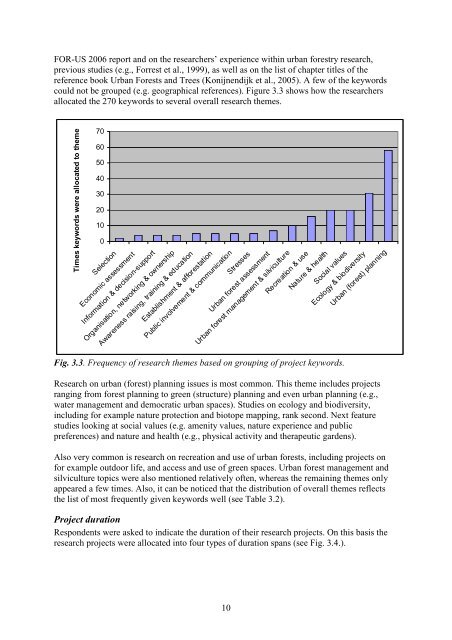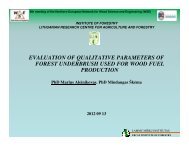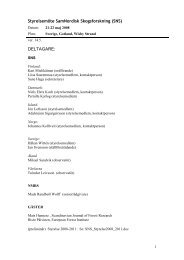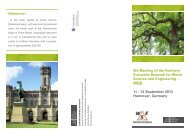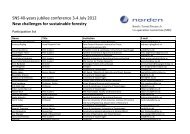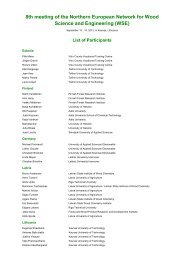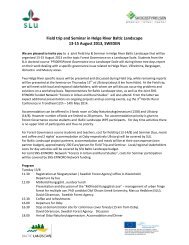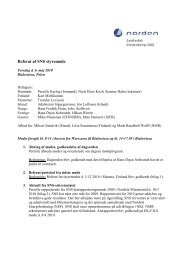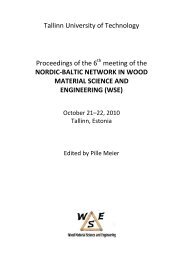Review of Urban Forestry Research in the Nordic Countries - SNS
Review of Urban Forestry Research in the Nordic Countries - SNS
Review of Urban Forestry Research in the Nordic Countries - SNS
You also want an ePaper? Increase the reach of your titles
YUMPU automatically turns print PDFs into web optimized ePapers that Google loves.
FOR-US 2006 report and on <strong>the</strong> researchers’ experience with<strong>in</strong> urban forestry research,previous studies (e.g., Forrest et al., 1999), as well as on <strong>the</strong> list <strong>of</strong> chapter titles <strong>of</strong> <strong>the</strong>reference book <strong>Urban</strong> Forests and Trees (Konijnendijk et al., 2005). A few <strong>of</strong> <strong>the</strong> keywordscould not be grouped (e.g. geographical references). Figure 3.3 shows how <strong>the</strong> researchersallocated <strong>the</strong> 270 keywords to several overall research <strong>the</strong>mes.Times keywords were allocated to <strong>the</strong>me706050403020100SelectionEconomic assessmentInformation & decision-supportOrganisation, network<strong>in</strong>g & ownershipAwareness rais<strong>in</strong>g, tra<strong>in</strong><strong>in</strong>g & educationEstablishment & afforestationPublic <strong>in</strong>volvement & communicationStresses<strong>Urban</strong> forest assessment<strong>Urban</strong> forest management & silvicultureRecreation & useNature & healthSocial valuesEcology & biodiversity<strong>Urban</strong> (forest) plann<strong>in</strong>gFig. 3.3. Frequency <strong>of</strong> research <strong>the</strong>mes based on group<strong>in</strong>g <strong>of</strong> project keywords.<strong>Research</strong> on urban (forest) plann<strong>in</strong>g issues is most common. This <strong>the</strong>me <strong>in</strong>cludes projectsrang<strong>in</strong>g from forest plann<strong>in</strong>g to green (structure) plann<strong>in</strong>g and even urban plann<strong>in</strong>g (e.g.,water management and democratic urban spaces). Studies on ecology and biodiversity,<strong>in</strong>clud<strong>in</strong>g for example nature protection and biotope mapp<strong>in</strong>g, rank second. Next featurestudies look<strong>in</strong>g at social values (e.g. amenity values, nature experience and publicpreferences) and nature and health (e.g., physical activity and <strong>the</strong>rapeutic gardens).Also very common is research on recreation and use <strong>of</strong> urban forests, <strong>in</strong>clud<strong>in</strong>g projects onfor example outdoor life, and access and use <strong>of</strong> green spaces. <strong>Urban</strong> forest management andsilviculture topics were also mentioned relatively <strong>of</strong>ten, whereas <strong>the</strong> rema<strong>in</strong><strong>in</strong>g <strong>the</strong>mes onlyappeared a few times. Also, it can be noticed that <strong>the</strong> distribution <strong>of</strong> overall <strong>the</strong>mes reflects<strong>the</strong> list <strong>of</strong> most frequently given keywords well (see Table 3.2).Project durationRespondents were asked to <strong>in</strong>dicate <strong>the</strong> duration <strong>of</strong> <strong>the</strong>ir research projects. On this basis <strong>the</strong>research projects were allocated <strong>in</strong>to four types <strong>of</strong> duration spans (see Fig. 3.4.).10


